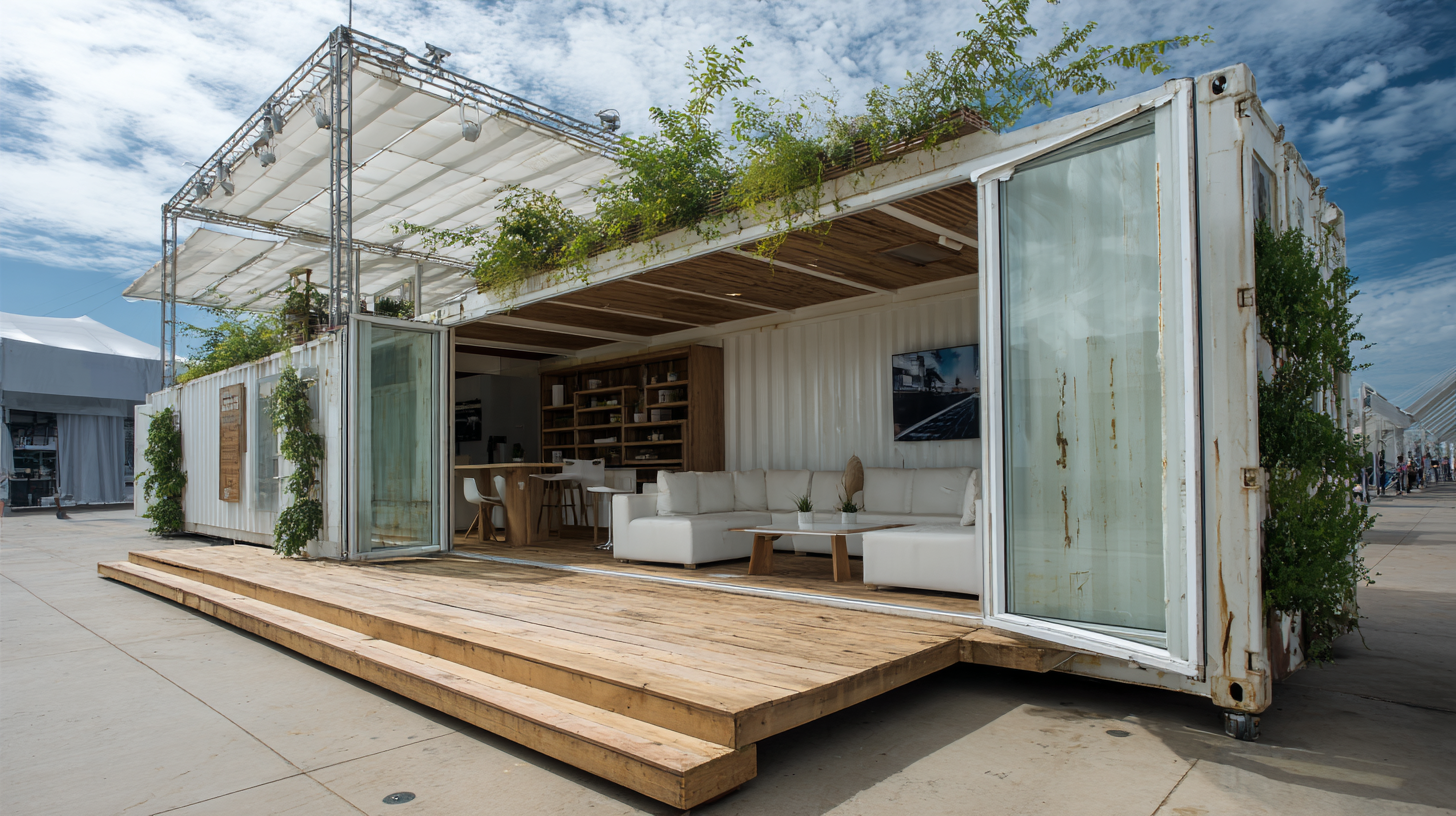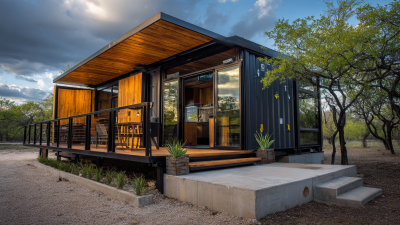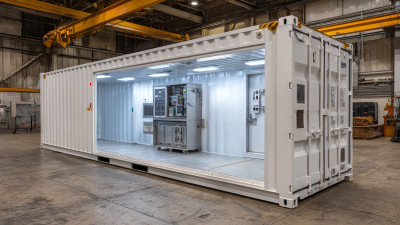Exploring the Future of Sustainable Living with Innovative Shipping Container Fabrication
In recent years, the concept of sustainable living has gained momentum, propelling innovative solutions into the spotlight. One such solution is the effective use of shipping container fabrication, a method that not only repurposes discarded containers but also contributes to eco-friendly housing and commercial spaces. According to Dr. Emily Carter, a leading expert in sustainable architecture, "The versatility of shipping container fabrication allows us to rethink how we approach housing, creating structures that are not only efficient but also minimize our environmental impact."

As we explore the future of sustainable living, it becomes increasingly clear that shipping container fabrication holds significant potential. From urban housing projects to unique office spaces, this innovative approach offers flexibility and sustainability, addressing the growing need for affordable and environmentally friendly construction methods. With engineered designs and creative layouts, shipping containers can morph into functional living spaces that break traditional design barriers while promoting eco-consciousness.
In this article, we will dive into the "Top 10" innovative applications of shipping container fabrication, showcasing how this forward-thinking method can revolutionize our approach to sustainable living. By understanding the immense possibilities that lie within this industry, we can better appreciate the role that shipping container fabrication will play in shaping the future of our communities and our planet.
Innovative Design Approaches for Eco-Friendly Shipping Container Homes
The trend of utilizing shipping containers for residential purposes has gained momentum in recent years, reflecting a growing shift towards sustainable living. Innovative design approaches have emerged, showcasing how container homes can be both eco-friendly and aesthetically pleasing. According to a recent market analysis by Research and Markets, the global green building market is projected to reach $1.8 trillion by 2030, demonstrating a significant shift towards sustainable construction methods.
Incorporating energy-efficient systems such as solar panels and rainwater harvesting can greatly enhance the sustainability of shipping container homes. With climate change concerns escalating, these practices not only reduce carbon footprints but also promote self-sufficiency. For those considering a shipping container home, here are some tips: prioritize insulation materials that have low environmental impact, and explore modular designs that allow for easy expansion without compromising ecological integrity.
Additionally, utilizing recycled materials in the interior finishes can further bolster a home’s eco-friendly credentials. A report by the World Green Building Council indicates that sustainable buildings can lead to a 20-30% reduction in energy usage. This not only results in lower utility costs but also contributes to a healthier living environment, reinforcing the importance of innovative designs that emphasize sustainability in shipping container living.
Integrating Renewable Energy Solutions in Container Living Spaces
As the world increasingly pivots toward sustainable living, integrating renewable energy solutions in
shipping container homes has become a vital aspect of eco-friendly design. These innovative living spaces can
harness solar power, wind energy, and even rainwater harvesting systems to create a self-sufficient habitat. By utilizing solar panels on the container rooftops,
residents can generate their own electricity, significantly reducing their carbon footprint while also cutting down on utility costs.
Tips for Integration: To maximize energy efficiency, consider positioning your shipping container
to leverage natural sunlight throughout the day. Additionally, installing high-quality insulation will keep your living space comfortable and minimize the energy
needed for heating or cooling.
Incorporating renewable energy solutions not only enhances the sustainability of shipping container homes but also promotes a lifestyle of independence. For instance,
small wind turbines can provide supplementary energy, especially in areas with consistent wind patterns. Furthermore, implementing energy-efficient appliances and
smart home technologies can optimize energy use, ensuring that your container home remains eco-friendly and modern.
Tips for Efficiency: Look into energy-efficient appliances and LED lighting,
which consume significantly less power. Lastly, creating a strong relationship with local suppliers of renewable energy technologies can help you stay updated on the
latest innovations and potential grants or subsidies for green living initiatives.
Maximizing Space Efficiency: Multifunctional Container Interiors
As the trend of sustainable living gains momentum, innovative shipping container fabrication is revolutionizing how we think about space utilization. The compact nature of shipping containers, which typically measure 20 to 40 feet in length, allows for remarkable flexibility in design, enabling them to be transformed into multifunctional living spaces. According to a report by the World Economic Forum, the global market for container homes is expected to reach $73 million by 2025, highlighting a growing demand for efficient and eco-friendly housing solutions.
Maximizing space efficiency not only involves creative design but also the integration of multifunctional interiors. For instance, modular furniture and hidden storage can enhance the usability of limited space. By employing convertible elements, such as a sofa that doubles as a bed or tables that fold away, residents can adapt their environment to suit various activities without compromising comfort. A study by the American Institute of Architects indicates that homes with efficient layouts can reduce the overall footprint by 20%, thus contributing to sustainability efforts.
**Tips for Maximizing Space in Container Homes:**
- Opt for vertical storage solutions, like shelving units that reach the ceiling, to utilize height effectively.
- Incorporate movable walls or partitions to create temporary rooms that can change based on daily needs.
- Choose light colors and transparent materials to enhance natural light and create an illusion of a larger space.
Exploring Sustainable Materials for Container Fabrication
The exploration of sustainable materials for container fabrication is a crucial step towards a more eco-friendly future. Traditional construction methods often result in significant waste and a large carbon footprint. However, using shipping containers as a base for innovative living spaces opens up possibilities for utilizing recycled and sustainable materials, dramatically reducing environmental impact. Materials such as sustainably sourced wood, recycled steel, and even innovative biomaterials can enhance the structural integrity and aesthetic appeal of container homes while being sensitive to ecological considerations.

Additionally, incorporating green technologies into the design and fabrication process can further elevate the sustainability of these structures. For instance, using insulated panels made from recycled materials can improve energy efficiency, while rainwater harvesting systems can be integrated to reduce resource consumption. By prioritizing the use of renewable resources and minimizing waste, the shipping container movement can pave the way for not only sustainable living but also a shift in how we think about construction. The fusion of creativity and environmental responsibility will likely lead to groundbreaking developments in the realm of sustainable architecture.
Case Studies: Successful Sustainable Container Living Projects Worldwide
 Innovative shipping container projects have emerged as a leading solution in sustainable living, offering flexible, cost-effective, and eco-friendly housing options across the globe. Cities like Boston are taking significant steps in their sustainability efforts, embracing initiatives like zero waste goals that align well with the shipping container concept. These containers not only serve as homes but also integrate seamlessly with urban landscapes, promoting responsible consumption and recycling.
Innovative shipping container projects have emerged as a leading solution in sustainable living, offering flexible, cost-effective, and eco-friendly housing options across the globe. Cities like Boston are taking significant steps in their sustainability efforts, embracing initiatives like zero waste goals that align well with the shipping container concept. These containers not only serve as homes but also integrate seamlessly with urban landscapes, promoting responsible consumption and recycling.
Case studies from various regions highlight successful sustainable container living projects that emphasize resource efficiency and community resilience. In Boston, the momentum toward a zero waste framework encourages the use of shipping containers for both residential and commercial purposes. Such projects are designed with sustainability in mind, featuring repurposed materials, energy-efficient designs, and systems for greywater recycling. This innovative approach not only reduces waste but fosters a sense of community around sustainable practices, making it clear that the future of urban living can be both inclusive and environmentally conscious.
Related Posts
-

Transforming Spaces: The Versatile Benefits of Custom Built Shipping Containers in Modern Architecture
-

Unlocking the Potential of Custom Built Shipping Containers for Sustainable Living Solutions
-

Unlocking the Potential: Innovative Uses for Specialty Shipping Containers in Modern Industries
-

Revolutionizing Modern Architecture: The Rise of Cargo Container Construction in Sustainable Living
-

Exploring the Versatility of Custom Cargo Containers: Innovative Uses for Modern Transport Needs
-

Innovative Uses of Construction Containers in Sustainable Urban Development

